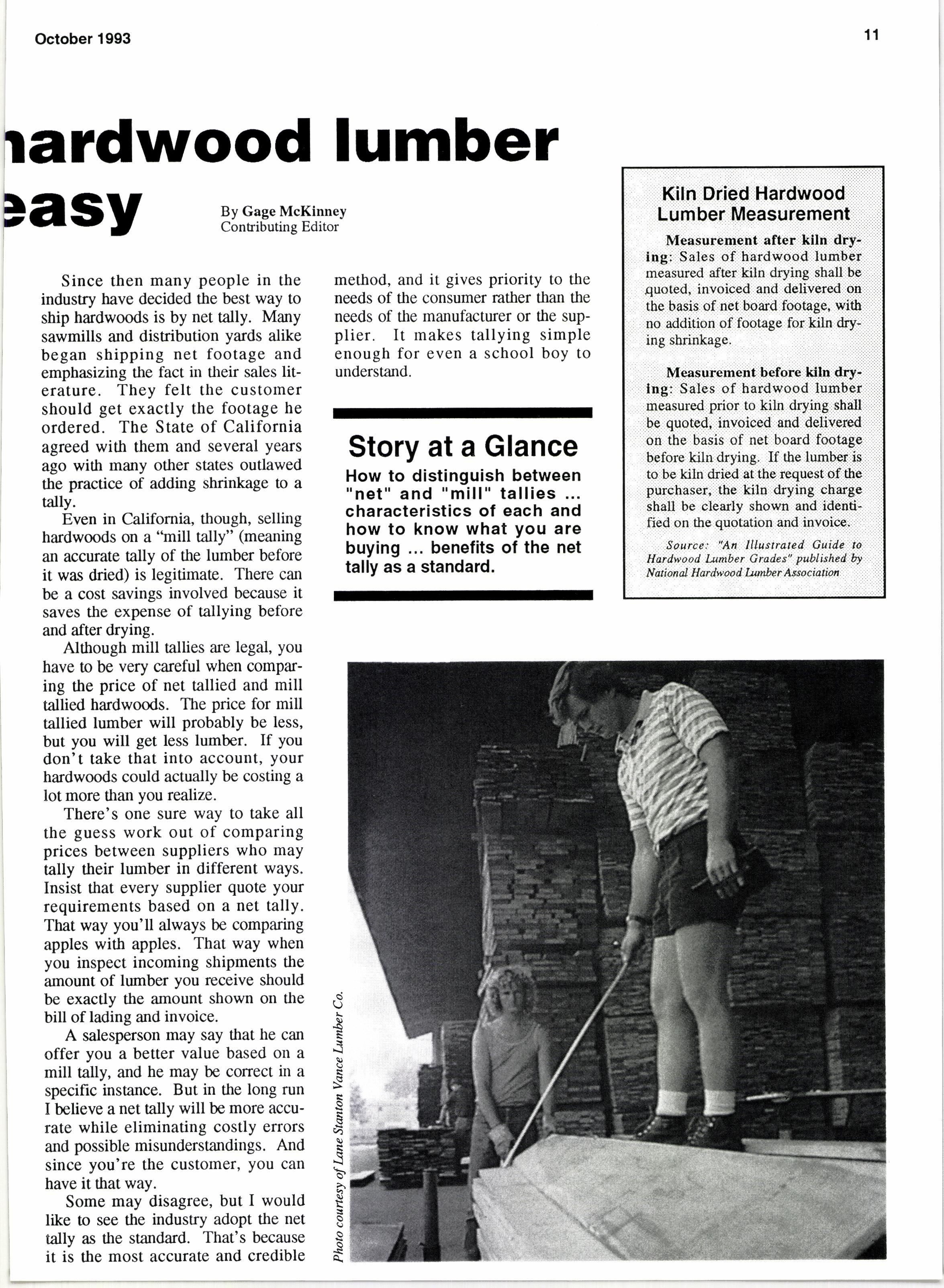
2 minute read
tardwood lumber Dasy
By Gage McKinney Contributing Editor
Since then many people in the industry have decided the best way to ship hardwoods is by net tally. Many sawmills and distribution yards alike began shipping net footage and emphasizing the fact in their sales literature. They felt the customer should get exactly the footage he ordered. The State of California agreed with them and several years ago with many other states outlawed the practice of adding shrinkage to a tally.
Even in California, though, selling hardwoods on a'tnill tally" (meaning an accurate tally of the lumber before it was dried) is legitimate. There can be a cost savings involved because it saves the expense of tallying before and after drying.
Although mill tallies are legal, you have to be very careful when comparing the price of net tallied and mill tallied hardwoods. The price for mill tallied lumber will probably be less, but you will get less lumber. If you don't take that into account, your hardwoods could actually be costing a lot more than you realize.
There's one sure way to take all the guess work out of comparing prices between suppliers who may tally their lumber in different ways. Insist that every supplier quote your requirements based on a net tally. That way you'll always be comparing apples with apples. That way when you inspect incoming shipments the amount of lumber you receive should be exactly the amount shown on the bill of lading and invoice.
A salesperson may say that he can offer you a better value based on a mill rally, and he may be conect in a specific instance. But in the long run I believe a net tally will be more accurate while eliminating costly errors and possible misunderstandings. And since you're the customer, you can have it that way.
Some may disagree, but I would like to see the industry adopt the net tally as the standard. That's because it is the most accurate and credible method, and it gives priority to the needs of the consumer rather than the needs of the manufacturer or the sup- plier. It makes tallying simple enough for even a school boy to understand.
Story at a Glance
How to distinguish between "net" and "mill" tallies .,. characteristics of each and how to know what you are buying benefits of the net tally as a standard.
, Kilh iDiied i.Hardrcod.,,'i'.'.,...., Lumber Measurement
Measurement after tltn drving,r',:,S alls Of:..nata*o.a.:.tuAU!f:,. measur,ed: aften, hiln drying:::$hall:.,be::::i quoled,;:,invoided and d€liv,ered ,,on, tbe,,basit,,of ,net .board rfootage, w.it$.,.,. no addition of footage for liln dry;r ing shrinkage.
r,r::: r,M.eaqurement,r,be..fore ktln:: t,,,', ilng,:.,Sales',of ,bdidwood,::lnmbcl iil measured,,p-r-iottokjlndr-ying,;,shalll'1,1 ,be,,,duoted;,,invoiced,,..and.dO1ive on the basis of net board foodgC before kiln drying. If the lumber,,is to,,be kiln fi ied r;at;the ;rcqtiest bf :tbs:ri:: pUldhaserl:,,tbC,,kilu,,dry:ingl,,charjC,, Cbaltr: be elbady showa andi.ideh$'i fied on fhe quotation:;and,invoice1,,,,,,
Source: 'An lllusrrated Guide'rb Hardwood ltmber A rades". publisheil'by: Nuioa aI Hardwioo d ltmhr,Associattam,'..,',',,:,,,..
,1|| S WITH most consumer 4lproducts, a strong opportunity lies within your fastener aisle to get your customers to trade up to higher dollar profit merchandise. A strategic "trade up" plan will result in a significantly stronger year-end dollar profit for you without any change in cosb, retails or margin structure. Remember the old adage: "We take profits, not margins, to the bank."
An effective trade up stmtegy consists of two simple elements:










